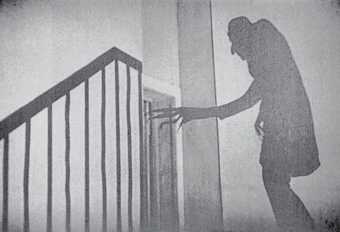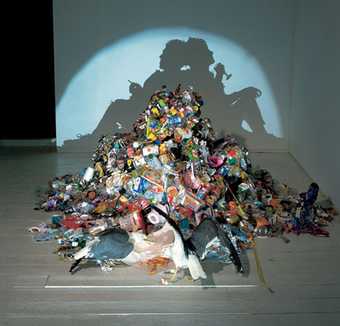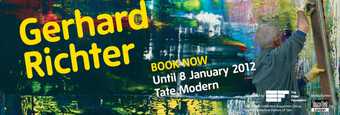The painter Giorgio de Chirico once wrote: “There are more enigmas in the shadow of a man who walks in the sun than in all the religions of the past, present and future. “De Chirico, who coined the term “metaphysical painting” while working with Carlo Carrà in 1917, may here have been speaking both as a painter and a metaphysician. If not automatically an enigma, it is at least mildly paradoxical that shadows can enlighten: that seeing some parts of what we see less well than others can help us to understand the whole of what we see better. Not being able to make out one edge of what might otherwise look like a triangle can lead you to realise you’re looking at a cone, for example. Yet de Chirico was mainly referring to the mood or feeling which shadow can generate, in art as in life. Its eminent usefulness in helping us to see form and perceive distance has not prevented it from being freighted down with all sorts of symbolic baggage. In folk tales, Gothic novels and film noir, shadows are premonitions, things menacingly half-seen, harbingers of threat or death. Western painting, or the representational tradition which has so dominated it, has tended to set shadow two seemingly contrasting tasks: to clothe, locate and define form – to make the picture’s flat surface appear to contain solid objects in space, producing something which looks real – and to lend a gloss of mystery or drama to the illusion created.
Often in art, though less so in ordinary acts of seeing, there is a difference between shadow in general and shadows in particular. A strong or precisely-directed light source casts shadows which closely resemble a cross section of an object placed in its path. The process is itself a kind of representation. Both Pliny the Elder and Quintilian cited the outlining of a shadow as a primal artistic act, but they disagreed about where this originating myth took place and the people involved in it. Pliny tells how the Corinthian Maid, daughter of the potter Butades, drew around her lover’s silhouette on a wall to remember him before he went abroad; for Quintilian it was a shepherd tracing his shadow on the ground with a stick. Both parables locate the origins of drawing in a kind of state of nature: domestic intimacy and romantic attachment in the former case, Arcadian pastoral in the latter. Both also feed off the transience of the shadow, its power to suggest absence as well as presence. Tomorrow his mapped shadow will be all the Maid has to remind her of her boyfriend, and the shepherd’s scratched image will surely have blown away.
The story of the Corinthian Maid in particular was widely depicted during the late eighteenth and early nineteenth centuries, reflecting the fashion for drawing among women of sensibility, while also perhaps suggesting that mere mechanical imitation was all an amateur – for which read female – artist could hope to achieve in the medium. The Maid’s use of a cast shadow as a template was, after all, in one sense a mechanical or even a kind of industrial process (her father came along later and filled in her drawing with terracotta). One of the most polished versions of the subject was painted in 1782–4 by Joseph Wright of Derby for Josiah Wedgwood, a potter like Butades, and someone keenly aware of the relationship between art and industry.
Conventional histories of Western painting begin not in antiquity – from which period inconveniently few examples have survived – but with the Renaissance. Shadow, or chiaroscuro, the interplay of light and shade, is mostly identified by Renaissance authors and later historians as a form-giving device, the handmaiden of perspective. But shadows are occasionally allocated a more pointed meaning. In the 1420s, Masaccio and Masolino organised their frescoes in the Carmelite church in Florence around clear and consistent depictions of light. Every scene in the cycle is lit as if by the chapel’s single high window. This consistency and clarity is most telling in Masaccio’s depiction of St Peter healing the sick with his shadow. The shadow falls in, as it were, the “right” place, as if Peter were being lit from the window to his left or our right. What looks like a straight reversal of the usual symbolism of menace and gloom may instead be a crafty reference to the death and resurrection of Christ – one flashes forward to the more obvious The Shadow of Death by Holman Hunt 1870–3, in which a young Jesus seems to be doing some sort of yoga pose while his shadow organises itself into a crucifixion behind him. In the Masaccio, Peter’s shadow passes over each of four unfortunates in turn; it is their restoration to the light which allows them to rise to their feet. The revolutionary intensity of Masaccio’s desire to represent, to paint figures who look as though they’re there, can be seen in religious terms as a kind of incarnation. Peter casts a shadow because he exists – or he exists because he casts a shadow. Making a miracle seem plausible to the point of ordinariness was itself, at the time,a miraculous achievement.
Nevertheless, the idea that Peter’s shadow is off doing good works on his behalf hints at a darker and more paradoxical tradition. Our shadows are our twins, our ghosts, our doppelgängers. Their relationship with us goes beyond the merely fraternal. The dramatic or even melodramatic properties of chiaroscuro have been exploited by artists for centuries, most effectively by the followers of Michelangelo da Caravaggio in seventeenth-century Rome, Naples, France and Holland. These so-called tenebristi or “shadowists” started from a dark ground, laying lighter colours over this to suggest the sparing and directed fall of light across the subject being depicted, picking out little details for the viewer and lending the whole scene a monumental, sombre presence.

F.W. Murnau
Nosferatu: A Symphony of Horror 1922
Film still
Light even corrals shadow into shadows here and there (as with the basket of fruit that throws a shadow in the shape of a fish’s tail in Caravaggio’s Supper at Emmaus 1601 at the National Gallery, an encrypted Christian symbol which subtly underpins the picture’s message of concealment and revelation). The artist’s touch can itself somehow be equated with light, and so with all the qualities light suggests. Weaving illuminated form out of inchoate darkness is a life-giving act with almost divine implications (“Let there be light!”). Yet the paintings are often set in what look very much like jail cells. You could call this ironic in that Caravaggio for one had first-hand experience of such interiors; you could also call it truthful, in that jail is where a lot of martyrdoms, for example, take place. But the abiding implication is that corporeal human life is a benighted state which even divine light often struggles to penetrate. Just as with Masaccio’s striving after objectivity, the apparent pessimism of the tenebristi allows modern viewers to disregard their work’s religious and allegorical content and see it as merely truthful.
Since the mid-nineteenth century it has been photography – especially monochrome photography – rather than painting in which this long-standing dependence on shadow to elucidate form and create mood has flourished (another way in which Caravaggio’s paintings appear modern to us is that they look a little like photographs). Brassaï’s Paris nocturnes, Ansel Adams’s sublime landscapes, Edward Weston’s nudes and still-lifes – all seem sketched in shadow rather than light. Even photographers who engaged more closely with the avant-garde and used the camera - or various camera-less photographic processes – to pursue the Modernist goal of abstraction, or to explore Modernist ideas of machine-made art, found themselves drawn to shadow as a resource, if not exactly a subject. Man Ray’s famous Rayographs are essentially negatives of shadows, luminous outlines of objects placed on a light-sensitive sheet which is then exposed (the process being oddly reminiscent of the Corinthian Maid). László Moholy-Nagy did something similar with his “photograms”; he also photographed layers of transparent material to create delicate, calligraphic patterns of diffracted shadow. In the 1970s Andy Warhol, an artist much exercised by the mechanical production and reproduction of images, made a series of “shadow pictures” which negated the old equation of shadow with formlessness (the let-there-be-light thing) by laying crisp silkscreened shadows over messily handpainted backgrounds.
An artist who has wrestled protractedly with the relationship between painting and photography (one might as well here call it “skiagraphy”, shadow-drawing) is Gerhard Richter. In the 1960s he started to make meticulous copies of photographs from newspapers, magazines and various apparently arbitrary sources. He initially said that he did this because “I had had enough of bloody painting, and painting from a photograph seemed to me the most moronic and inartistic thing that anyone could do”. With the years came a certain gravitas. Richter began to talk about the need to express present reality, about the way in which photographs had come to saturate people’s visual lives and with the transfiguration of the photograph into art by the sheer exertion of painting. He edged towards traditional high art modes such as allegory and history painting. His technique developed. The laboured execution of his early photo paintings (by the 1970s he was also doing abstracts, some monochromatic, some garishly coloured) gave way to an austere refinement. By sponging and glazing the picture surface, before passing a very fine brush over it, he obliterated every trace of a brush stroke, blurring the resulting image in a way which made it oddly very unlike a photograph, but instead rather like seeing a reflection in burnished lead, or glimpsing something through the tinted window of a fast car.
In 1988 Richter exhibited fifteen paintings of members of the Baader-Meinhof gang, a revolutionary terrorist under the umbrella of the Red Army Faction, at MoMA, New York. Shadow engulfs the pictures, obliterating rather than elucidating form. The artist’s agitation of the painted surface means, for example, that you can’t make out the titles of the books in Andreas Baader’s cell, or read that the LP on the hollowed-out record player, inside of which the pistol that killed him was smuggled, was, incongruously, There’s One in Every Crowd by Eric Clapton. The paintings seem disinclined to engage too closely with their fiercely controversial subjects – political violence, suicide, even (it was widely rumoured at the time) state-sanctioned murder. As in the tenebrist tradition (though Richter was scathing about an earlier attempt by the Norwegian painter Odd Nerdrum to depict Baader’s “murder” in a straight pastiche of Caravaggio’s style), tone in the optical sense determines tone in the emotional ones. The pictures insist on the dignity of the dead, but also on the mundane materiality of death. Shadow makes them dense and concrete, but also deeply ambiguous, their meaning and sympathy (again, Richter has consistently condemned extremist ideologies of any sort) endlessly negotiable.
Many modern artists have been less concerned by such things, of course. The striving of the Impressionists and their successors after an art of luminosity and harmony – an art in which even shadows seem to glow (actually they knew that shadows are colour) – tended to make shadow a more marginal element. The pursuit of abstraction might seem to make it still more redundant, though Kandinsky, for example, appears to use something very like shadows in his angular abstracts of the 1920s, and Ben Nicholson’s monochrome reliefs would be all but invisible in true ambient - that is, directionless and shadowless – light. Nevertheless, modern painters have used shadow to express feeling as well as to explore representation. The unheimlich (uncanny) qualities of shadow are exploited in de Chirico’s eerie townscapes of 1913–14, which anticipate the disquieting dreamscapes of the Surrealists by a good decade. De Chirico exploits and subverts the Renaissance tradition of figures serenely located in harmonious perspective boxes. His technique – during this period, at least – is scratchy and naïve. Figures are dogged by their shadows, which are distended to suggest a declining summer sun. A distorted and simplified architectural framework is also scythed by shadow. His world is paradoxical and unintelligible; his shadows are faceless, inscrutable, binding their corporeal partners to the earth, isolating them from one another.
One straightforwardly “enigmatic” device used by de Chirico is to include a shadow, but occlude or exclude the body which casts it. Others employ versions of the same trick. Bacon does it in his 1951 Portrait of Lucian Freud. The subject’s shadow wriggles weakly away from him, while another, which may or may not be Bacon’s, looms towards Freud from the right foreground. Picasso does it in two similar paintings from 1953, The Shadow on the Woman at the Art Gallery of Ontario, Toronto, and The Shadow at Musée Picasso, Paris. The encroaching shadow of an unseen onlooker adds a fresh twist of ambiguity to one of his favourite themes, a sleeping figure observed. It may represent the artist, or the viewer of the painting, or someone else. It seems male, and so may represent a spectre of desire, or even the proverbial shadow of mortality haunting unselfconscious youth. It is heavy and blank in comparison with the meandering linear rendering of the recumbent figure. The pictures constitute a good example of how problems of narrative and problems of representation can mirror each other. Picasso is consistently inconsistent in his use of shadow throughout his post-1907 career. A dour Cubist outing from 1911 might chop shadows up into a sort of chessboard across the picture; a print from twenty years later might team one figure done in a “classical” – that is, among other things, shadow-casting – way with another represented very differently. With these juxtapositions Picasso wants us to admire his tightrope-walking skills, but he also knows that shadow on a figure makes us tend to characterise that figure in a certain way – be it earthbound, predatory, ancient or whatever.
The rise of installation art has brought us back to the Corinthian Maid and beyond, all the way to Plato’s Cave, a hellish oubliette – there are a lot of jail cells in this story – where prisoners mistake shadows for reality. Marcel Duchamp was exercised – a better word might be amused – by the problems shadows posed the artist. His frieze Tu M’ of 1918 contained painted depictions of shadows, as well as “real” shadows cast from protruding bits of collage, while versions of his lost first readymade Bicycle Wheel 1913 have often been installed in such a way as to project a shadow behind them. In the post-Duchampian carnival where anything at all can be deemed to be art, shadows need no longer be faked through any kind of picture-making process, but can be physically generated on a gallery wall by shining real light on real objects. Tim Noble and Sue Webster have made a number of assemblies of junk which generate clear, figurative silhouettes when spot-lit. Miss Understood and Mr Meanor 1997 resolved into the shadow of two severed heads on spikes; another piece, Dirty White Trash (With Gulls) 1998, discloses a boozy pair of lovers reclining back to back. Noble and Webster have been criticised for the vaudevillian quality of their work, not to mention its narcissism. But their shadow pieces show an acute understanding of the iconography of shadow. Choosing to make romantic, transcendent images out of random disjecta inverts the long-established notion of shadow as formlessness. The Gothic quality of other pieces is a sly dig at shadow’s portentous heritage. The work has roots not only in popular illusionism and the skiagraphs or shadowplays of childhood, but also in an artistic lineage of curiosity and caprice. One is reminded of Arcimboldo’s composite portraits or Holbein’s anamorphic projections. Meanwhile, the physical fragility of the pieces is very much in keeping with shadow’s symbolic inheritance, this time as an emblem of earthly vanities. Appropriately, perhaps, Miss Understood and Mr Meanor was a casualty of the Momart warehouse fire of 2004.


